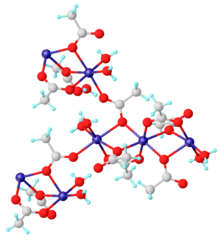Manganese(II) acetate
 From Wikipedia the free encyclopedia
From Wikipedia the free encyclopedia
 | |
| Names | |
|---|---|
| IUPAC name Manganese(II) acetate | |
| Other names Manganese diacetate | |
| Identifiers | |
| |
3D model (JSmol) | |
| ChemSpider | |
| ECHA InfoCard | 100.010.305 |
PubChem CID | |
| UNII |
|
CompTox Dashboard (EPA) | |
| |
| |
| Properties | |
| Mn(CH3CO2)2 (anhydrous) Mn(CH3CO2)2·4H2O (tetrahydrate) | |
| Molar mass | 173.027 g/mol (anhydrous) 245.087 g/mol (tetrahydrate) |
| Appearance | white crystals (anhydrous) light pink monoclinic crystals (tetrahydrate) |
| Density | 1.74 g/cm3 (anhydrous) 1.59 g/cm3 (tetrahydrate) |
| Melting point | 210 °C (410 °F; 483 K) (anhydrous) 80 °C (tetrahydrate) |
| Solubility | soluble in water (about 700g/L at 20°C for tetrahydrate), methanol, acetic acid (anhydrous) soluble in water, ethanol (tetrahydrate) |
| +13,650·10−6 cm3/mol | |
| Hazards | |
| NFPA 704 (fire diamond) | |
| Flash point | > 130 °C (266 °F; 403 K) (tetrahydrate) |
| Lethal dose or concentration (LD, LC): | |
LD50 (median dose) | 2940 mg/kg (rat, oral)[2] |
| Related compounds | |
Other anions | Manganese(II) fluoride Manganese(II) chloride Manganese(II) bromide |
Other cations | Zinc acetate Mercury(II) acetate Silver acetate |
Except where otherwise noted, data are given for materials in their standard state (at 25 °C [77 °F], 100 kPa). | |
Manganese(II) acetate are chemical compounds with the formula Mn(CH3CO2)2·(H2O)n where n = 0, 2, 4. These materials are white or pale pink solids. Some of these compounds are used as a catalyst and as fertilizer.[3]
Preparation[edit]
Manganese(II) acetate can be formed by treating either manganese(II,III) oxide or manganese(II) carbonate with acetic acid:[4]
- Mn3O4 + 2 CH3CO2H → Mn(CH3CO2)2 + Mn2O3 + H2O
- MnCO3 + 2 CH3CO2H → Mn(CH3CO2)2 + CO2 + H2O
Structure[edit]
The anhydrous material and dihydrate Mn(CH3CO2)2·2H2O are coordination polymers. The dihydrate has been characterized by X-ray crystallography. Each Mn(II) center is surrounded by six oxygen centers provided by aquo ligands and acetates.

References[edit]
- ^ Lide, David R. (1998), Handbook of Chemistry and Physics (87 ed.), Boca Raton, FL: CRC Press, pp. 3–354, 4–68, ISBN 0-8493-0594-2
- ^ "Manganese compounds (as Mn)". Immediately Dangerous to Life or Health Concentrations (IDLH). National Institute for Occupational Safety and Health (NIOSH).
- ^ Thomas Scott; Mary Eagleson (1994), Concise Encyclopedia Chemistry, Walter de Gruyter, p. 620, ISBN 3-11-011451-8, retrieved 2009-07-20
- ^ Arno H. Reidies (2002). "Manganese Compounds". Ullmann's Encyclopedia of Industrial Chemistry. Weinheim: Wiley-VCH. doi:10.1002/14356007.a16_123. ISBN 3527306730.
- ^ Chih-Yi Cheng; Sue-Lein Wang (1991). "Structure of manganese acetate dihydrate". Acta Crystallographica Section C. 47 (8): 1734. doi:10.1107/S0108270191002202.
